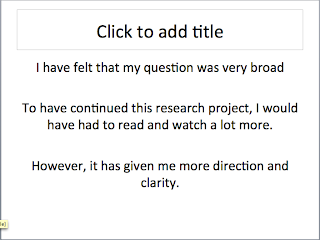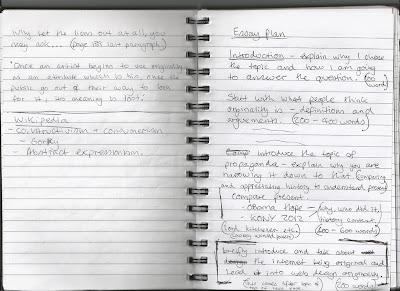Below are my notes and slides from the presentation I gave on my essay.
Notes
Can new design be
original?
Click
I chose this question
because
-
I am interested in design in all areas
-
and have debated it for many years
-
it is one reason why I got into Art and design
click
-
I
have questioned whether you could be original if you concentrate (so if you
truly sit and think) or does it just happen?
-
When
a human thinks about something, can
you fully create something new or will you always be influenced by something.
click
-I have never had any strong feelings or
opinions, just more and more questions.
- theres never been a clear answer.
Click
- I have read many books including
‘the postmodernism reader’, ‘Postmodernism and Popular culture’ which
was to find a postmodernism view.
- Have
also read articles found on the web including the uwe online library.
- I
have watched documentaries including ‘Helvetica’, which does focus on typo but
has very general subjects.
- Interviews
with designers such as Alan Fletcher.
Click
- the source that has change my
feelings the most was an documentary called Mead generations which included an
interview with Paul Rand on
typography and originality.
-
- Try and play the video
-
- He quotes ‘do not try to be
original, try to be good’
- Interpreting this quote could be
done in many different ways, I understand it as Rand feels originality isn’t so important anymore, or even if
it ever was.
- Further on he quotes ‘originality is
not something you decide your going to be, that is the product of your brain’
- This is moving away from my original
question but it helped me understand a profession opinion, which is that, if
you are original, you are original meaning that it is perfectly possible but it
cannot be forced.
Click
-
During my research, I found it hard to pin point
key theorists that continue to write about this subject, I found that it is
more of a one off opinion over it being a question that is constantly argued.
-
From the sources I read however, there was a
contrast of opinions.
-
David Hare, the writer of the art journal ‘The
Myth of Originality in Contemporary Art’ writes about originality in a way that
may describe a piece of art to only be an original, as in the first of
something.
-
He doesn’t talk much of originality in the
meaning of the work being creatively original apart from quoting ‘ideas will
always be repeated, but when was the idea ever original?’
-
He answers my question with another question.
Click
- I feel that my question was very
broad and required more research which means longer than 1500 words.
-
To
have continued this research project, I would have to read and watch a lot
more. I feel that within 1500 words, the quality was adequate although I
haven’t formed an actual answer, only more questions but more direction.
Click
-
As a design practitioner myself, the biggest
influences that have changed the way I feel about originality was the thoughts
and opinion of Paul Rand.
-
The quote ‘Do not try to be original, just try to be good’ has made me feel that
originality has become less important in our modern day. It is more important
to be simple, clear and to communicate your ideas effectively whether it is
original or not.
Click
-
To have improved my efforts in this module, I
would have liked to have read more and to have put in a lot more time. This
would be my advise to anyone under taking something similar in the future.
Slides
Overall, I think my presentation went really well. I was very nervous about it as I wasn't very confident about the essay itself but it worked out well. I received some positive feedback that I was happy with and some feedback for next time.
I know exactly what to do next time, which is more reading, more note taking, spreading it out over a longer time to give myself some time to think about the subject and to write up more draft versions.
Note. Learn the proper Harvard reference system.
















